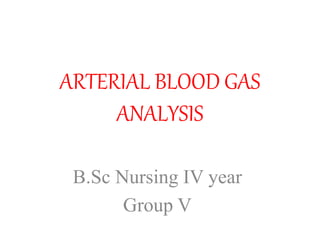
Arterial Blood Gas Analysis
- 1. ARTERIAL BLOOD GAS ANALYSIS B.Sc Nursing IV year Group V
- 2. INTRODUCTION Arterial blood gases are an important routine investigation to monitor the acid-base imbalance of the patient. They may help to make diagnosis ,indicate the severity of condition and help to assess treatment. Blood for ABG analysis can be obtained by arterial puncture usually from radial and femoral artery. Bicarbonate helps in maintaining blood pH value. Kidney and lungs work in our body as compensatory mechanism.
- 4. PURPOSE To determine the presence and type of acid – base balance. To check for severe breathing problem and lungs diseases. Assessment of the response to the therapeutic intervention such as mechanical ventilator.
- 5. INDICATION Respiratory failure Ventilated patient Cardiac failure Renal failure Sepsis and Burn Poisoning
- 8. Types of Acid-Base Imbalance Respiratory Acidosis Respiratory Alkalosis Metabolic Acidosis Metabolic Alkalosis
- 11. Causes of Respiratory Acidosis Hypoventilation Neuromuscular Weakness (Gullian Barre Syndrome) Obesity Asthma
- 12. Clinical Manifestation Muscular Weakness Tachypnea Blurred Vision Confusion Memory loss Restlessness
- 13. Management Pharmacological:- • Opoid Antagonist:- Nalaxone • β2 Antagonist:- Formoterol, Albuterol • Anticholinergic:- Ipratropium bromide • Corticosteroids:Prednisone,Prednisolone
- 14. Non pharmacological:- • Dialysis:- To clear the toxin from blood. • Oxygen Therapy:- To minimize the chance of hypoxemia. • Ventilator Support:- To subside the respiratory problem.
- 16. Causes Hyperventilation Fluid loss Liver disease Alteration in gas exchange Pneumonia Stress
- 17. Clinical Manifestation Palpitation Tetany (muscle spasm) Convulsion Paralysis Chest pain
- 18. Management Pharmacological:- • Antibiotic: Levofloxin •Antipyretic: Acetaminophen •Anxiolytic: Benzodiazapam Non-pharmacological:- • Breath into a paper bag. •Restrict oxygen intake into the lungs.
- 19. •To reassure the patient who is anxious. • Treat the underlying causes. •If intubated, reduce minute ventilation by adjusting rate ,tidal volume.
- 21. Causes • Alcohol • Cancer • Diarrhea • Liver failure • Poisoning by aspirin and methanol • Sever dehydration • Seizure
- 22. Clinical Manifestation Diarrhea Chest pain Rapid breathing Hypotension Arrhythmia Joint pain
- 23. Management Pharmacological:- • Ringer lactate • Diuretics • Administer bicarbonates Non-pharmacological:- • To provide IV fluid. • Stop drinking alcohol. • To provide plenty of fluid.
- 25. Causes • Alcohol abuse • Hyperaldesteron • Diarrhea and vomiting • High fever • Diuretic therapy • Cystic fibrosis
- 26. Clinical Manifestation Bradypnea( initial symptom) Apnea go on 15 sec and longer Decrease blood pressure Rapid heart rate Irritability Cyanosis Coma
- 27. Management Pharmacological:- • Potassium sparing diuretics: Amiloride • Antipyretic:- Acetazolamide • Infuse HCL Non-pharmacological:- • Dialysis • To check vital sign of the patient. • To provide antacid and laxative.
- 28. Nursing Management • Impaired gas exchange • Ineffective Breathing pattern • Ineffective tissue perfusion • Risk of infection at puncture site • Risk of injury
- 29. Procedure of Arterial Blood Gas analysis
- 30. Equipment Required A clean tray containing: • Gloves • Antiseptic solution • Local anesthesia • 0.5 ml sodium heparin( 1:1000) • 2 – 3 ml syringe with 20, 23 and 25 gauze needle. • Paper bag
- 32. Preparation of client To record the temperature of the client. Record inspired oxygen concentration of the client. Heparnised the syringe to prevent blood clotting. To reduce anxiety of the client. Allen’s test
- 35. Sample Collection Wash hands and wear gloves. Place pillow under the patient’s wrist. Palpate the artery i.e radial, brachial or femoral to be punctured. Obliterate both radial and ulnar arteries at wrist by pressing them with both thumbs. Ask the patient to clench and unclench the fist until blanching of skin occurs.
- 36. Release the pressure on the ulnar artery by removing the thumb on it. Watch for return of circulation to skin with in 15 sec. Palpate the radial artery for pulsation. Puncture the artery at 45-60° angle. The arterial blood rushes into the syringe with a great force. We should withdraw 2-3 ml of blood for sample.
- 38. Once the sample has been taken, withdraw the needle and apply firm pressure over the site of puncture with dry sponge. Remove the air bubble from syringe and needle. Capping the needle. Place the capped syringe into an ice container. Maintain firm pressure on puncture site for 5 min. If patient is on anticoagulants use the high pressure dressing.
- 39. Follow-up Send the collected sample to the laboratory immediately. Assess for cold hands or numbness. Change the ventilator settings.
- 40. Complication of ABG Bleeding Infection at puncture site Blood accumulating under skin Local pain Thrombus in artery Feeling faint Numbness of hand
- 41. Contraindication of ABG Coagulopathy Artherosclerosis Infection at insertion site Abnormal modified Allen’s test Use of thrombolytic agent
